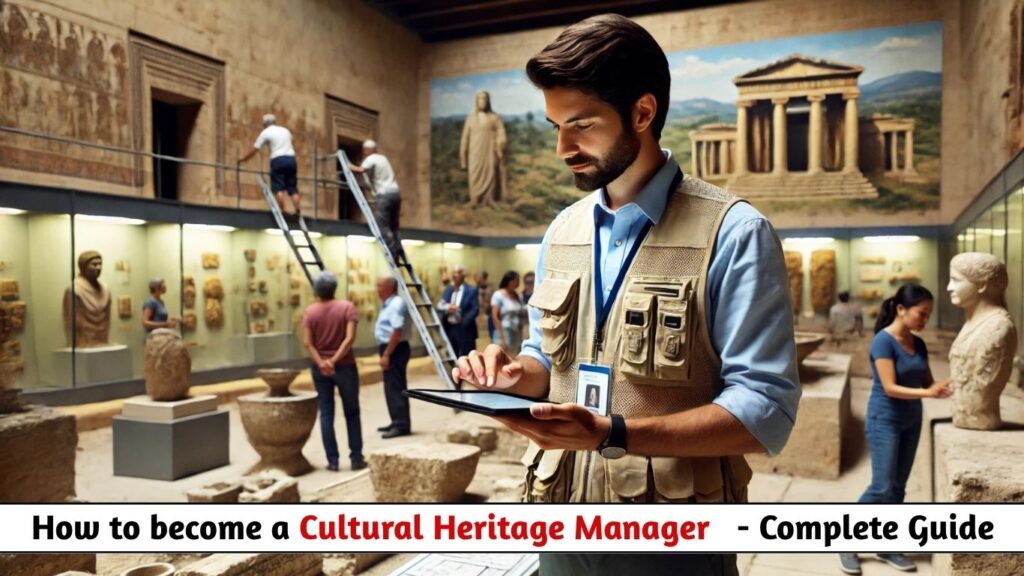
Introduction
A Cultural Heritage Manager plays a vital role in preserving and promoting the world’s historical, artistic, and archaeological treasures. These professionals work in museums, UNESCO sites, government agencies, and private conservation organizations to protect cultural legacies while making them accessible to the public.
This comprehensive guide covers:
✔ History of cultural heritage management
✔ Salary expectations globally
✔ Key roles & responsibilities
✔ Required qualifications & skills
✔ Step-by-step career roadmap
✔ Future trends & digital innovations
History of Cultural Heritage Management
Ancient Foundations (3000 BCE–1700s)
- Egypt & Mesopotamia: First recorded efforts to preserve temples and artifacts.
- Roman Empire: Created early “museums” to display war spoils.
Modern Preservation Movement (1800s–Present)
- 1850s: First heritage laws passed (UK’s Ancient Monuments Protection Act).
- 1972: UNESCO’s World Heritage Convention established global standards.
- 21st Century: Digital archiving, 3D reconstructions, and AI-powered conservation.
Cultural Heritage Manager Salary
Salaries vary by country, employer, and specialization:
| Position | Average Salary (USD/Year) | Top Earners (USD/Year) |
|---|---|---|
| Entry-Level (Museum Assistant) | $35,000 – $50,000 | $60,000+ |
| Mid-Career (Site Manager) | $55,000 – $80,000 | $100,000+ |
| Senior (UNESCO/Government) | $90,000 – $130,000+ | $150,000+ |
Factors Affecting Salary
✔ Location (Europe/US pay more than developing nations)
✔ Employer (Private foundations vs. NGOs)
✔ Specialization (Digital heritage experts earn premiums)
Roles & Responsibilities
1. Conservation & Restoration
- Overseeing artifact preservation (climate control, anti-theft measures).
- Collaborating with archaeologists and chemists.
2. Public Engagement & Education
- Designing museum exhibits and interactive tours.
- Managing community outreach programs.
3. Policy & Compliance
- Ensuring adherence to UNESCO/ICOMOS guidelines.
- Lobbying for heritage protection laws.
4. Digital Archiving
- Using 3D scanning, VR, and blockchain for artifact documentation.
5. Fundraising & Grants
- Securing donations for restoration projects.
Qualifications & Skills Required
1. Education
- Bachelor’s: Art History, Archaeology, or Museum Studies.
- Master’s/PhD: Cultural Heritage Management (Top programs: UCL, NYU).
2. Certifications
- ICOM Certification (International Council of Museums).
- UNESCO World Heritage Site Management.
3. Essential Skills
✔ Research & analytical skills
✔ Project management (software like Trello, Asana)
✔ Multilingualism (French, Spanish, Arabic preferred)
How to Get Started
Step 1: Gain Field Experience
- Volunteer at local museums or dig sites.
- Intern with National Trust or UNESCO.
Step 2: Build Technical Expertise
- Learn GIS mapping, 3D modeling (Blender).
- Take courses in preventive conservation.
Step 3: Network
- Join ICOM, AAM (American Alliance of Museums).
- Attend Europa Nostra conferences.
Step 4: Apply for Jobs
- Target Smithsonian, Getty Museum, or national ministries.
Future Scope & Trends
1. High-Demand Regions
- Middle East (Louvre Abu Dhabi, Neom projects).
- Asia (Angkor Wat, Great Wall sustainability initiatives).
2. Emerging Trends
✔ AI for Artifact Authentication (Detecting forgeries).
✔ Metaverse Museums (Virtual reality exhibitions).
3. Alternative Careers
- Cultural Tourism Consultant
- Heritage Impact Assessor (For construction projects)
Conclusion
Cultural Heritage Management merges passion for history with cutting-edge tech. With global demand rising for preservation experts, this career offers intellectual fulfillment and travel opportunities.
Start by volunteering—your work could save a UNESCO World Heritage Site!
Need details on specific certifications? Comment below! 🏛️













Post Comment